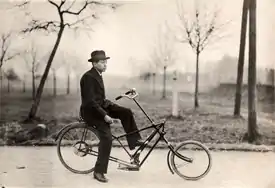
Paul Jaray (Hungarian: Járay Pál; 11 March 1889 – 22 September 1974) was an Austrian engineer, designer, and a pioneer of automotive streamlining.
Life

.jpg.webp)
Paul Jaray came from one of the oldest Prague-born Jewish families of scholars and artists called the Jeitteles, later his family moving to the Hungarian part of the Austro-Hungarian Empire.[1] Jaray, of Hungarian-Jewish descent, was born in Vienna. Jaray studied at Maschinenbauschule in Vienna and worked at the Prague Technical University as an assistant to Professor Rudolf Dörfl.
Later he became the chief design engineer for the aircraft building firm Flugzeugbau Friedrichshafen, designing seaplanes. From 1914[2] Jaray worked at Luftschiffbau Zeppelin, located in the same town, concentrating on streamlining airships. Jaray designed the airship LZ 120 Bodensee[3] on which airships such as the LZ 127 Graf Zeppelin, the LZ 129 Hindenburg and the LZ-130 were later based.[4] Further experiments in LZ's wind tunnel led to his establishment of streamlining principles for car designs. In 1923 he moved permanently to Switzerland, opening an office in Brunnen.
In 1923[5] Jaray founded the Stromlinien Karosserie Gesellschaft, which presented numerous designs for streamlined car body work. It issued licences to major vehicle manufacturers including Tatra Works in Kopřivnice, Czechoslovakia. Tatra was the only manufacturer that used Jaray's streamlining principles purchasing his licences for their car production. Jaray designed car bodies for other manufacturers starting with the 1922 Ley and followed on with designs for Chrysler, Mercedes-Benz, Maybach, Apollo, Dixi, Audi, Adler, Jawa, Ford, Steyr and others.[6]
His own 1934 car was built on a Audi 2-litre Front chassis with a body by Huber and Brühwiler of Lucerne.[7] Jaray also designed the body for the streamlined Auto Union Typ B Lucca Rennlimousine in 1934.[8] Jaray was also interested in radio and television technology. In 1941 he worked for Farner AG in Grenchen on nosewheel undercarriage design. In 1944 he set up as an independent engineer working on wind-driven power station.[9] He was the author of a large number of technical patents relating to streamlining, air compressors for railway, and devices for handling gases in silencers. Later he lectured at the Eidgenoessische Technische Hochschule (Swiss Federal Institute of Technology), Zürich.
Jaray died in 1974 in St. Gallen.
See also
Notes
- ↑ Scheppe, Wolfgang (2023). Paul Jaray - Die Vernunft der Stromlinie. Berlin: Kunsthaus Dahlem. p. 4.
- ↑ "Paul Jaray Biography". Retrieved 20 October 2020.
- ↑ "col – air ministry – fineness ratio – 1928 – 0280 – Flight Archive". flightglobal.com. Retrieved 28 August 2015.
- ↑ Kveton, Michael (September 2017). "Paul Jaray". Motor Journal. Vol. XVII, no. 185. pp. 50–51.
- ↑ Just, Marcel (2020). "Stromlinienfaszination – Hans Erni und Paul Jaray". k+a (kunst+architektur). No. 2. p. 79.
- ↑ Bröhl, Hans Peter (1978). Paul Jaray - Stromlinienpionier von der Kastenform zur Stromlinienform. Bern. pp. 36–158.
{{cite book}}: CS1 maint: location missing publisher (link) - ↑ Bröhl, Hans Peter (1978). Paul Jaray - Stromlinienpionier von der Kastenform zur Stromlinienform. Bern. pp. 75–77.
{{cite book}}: CS1 maint: location missing publisher (link) - ↑ Kieselbach, Ralf J F (1982). Stromlinienautos in Deutschland. Stuttgart: Verlag W. Kohlhammer. p. 169. ISBN 3170076264.
- ↑ "Paul Jaray". Unique Cars and Parts. Retrieved 2 October 2023.
External links
- BMW Car Designers Paul Jaray in the overview of the BMW automotive designers.
References
- Lichtenstein, Claude, ed. (1994). The Esthetics of Mninimized Drag: Streamlined, A Metaphor for Progress. Baden: Lars Mueller Publishers. ISBN 3-906700-71-2.
- Broehl, Hp. (1978). Paul Jaray Stromlinienpionier von der Kastenform zur Stromlinienform. Bern.
{{cite book}}: CS1 maint: location missing publisher (link) - de Syon, Guillaume: 'The Teardrop that Fell From the Sky: Paul Jaray and Automotive Aerodynamics', ITEA Journal 2008, 29, pp. 14–16
- Scheppe, Wolfgang (2023). Paul Jaray - Die Vernunft der Stromlinie. Berlin: Kunsthaus Dahlem.